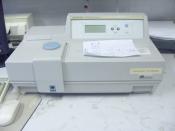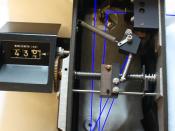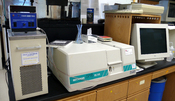History
The modern spectrophotometer has taken decades to be invented. French scientists had drawn the preliminary sketches for a spectrophotometer in the 1890s but the technology of that time was insufficient to build one. The modern spectrophotometer was finally perfected in 1939 by the American chemist Arnold O. Beckman (1900-2004). The early spectrophotometer was invented before World War II and was used during the war by the government to check for food poisoning and for experiments to make atomic bombs. The invention of the spectrophotometer has impacted a wide range of fields from physics to chemistry and has led to the discovery of unknown properties of light.
How it works
The modern spectrophotometer, popularly termed the UV (ultraviolet) spectrophotometer, does not always use radiation; in some cases, radiowaves with shorter wavelengths have been used. The spectrophotometer works by first emitting ultraviolet radiation using either tungsten or molybdenum bulbs. The radiation then goes through a monochromator.
The monochromator consists of a prism and a colored glass slide. The prism breaks the radiation into bands of wavelengths or frequency. The waves then pass a colored glass slide, which only permits waves of a certain frequency to go through. After the waves pass the monochromator, it goes through a sample placed between the monochromator and a frequency detector. The sample absorbs some of the waves and lets the other waves go through them. The remaining waves go through the sample and are detected by the frequency detector. Each type of compound absorbs only a given amount of frequency. By detecting the amount of frequency that has NOT been absorbed by the sample, it is possible to determine the identity of sample.
What it does
"A spectrophotometer is a photometer (a device for measuring light intensity) that can measure intensity as a function of...


